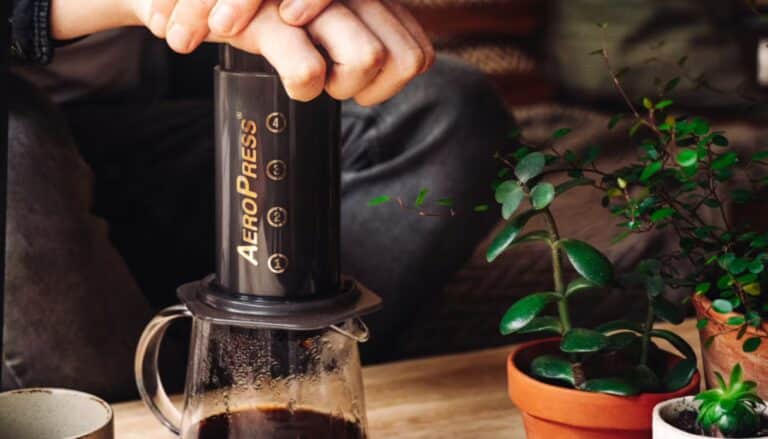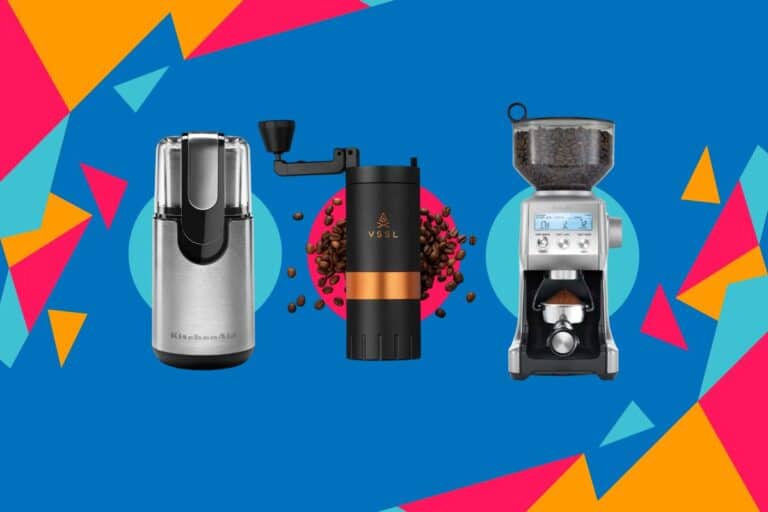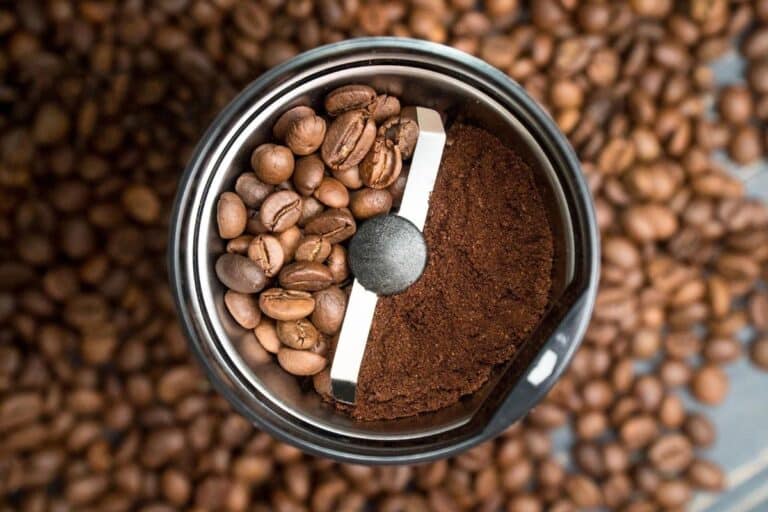People love decaf coffee because it lets them enjoy all the good stuff about coffee without the caffeine kick. Decaf, short for decaffeinated coffee, is perfect for anyone who gets jittery from caffeine or wants to cut down for health reasons. Even though decaf has been around for a long time, it still has lots of fans. These coffee lovers can sip on decaf any time they want without worrying about staying up all night or feeling shaky.
Why do some people pick decaf over regular coffee? Health is a big reason. If you have issues like anxiety, heart problems, or high blood pressure, your doctor might tell you to drink less caffeine. Pregnant or breastfeeding moms also choose decaf to keep caffeine away from their baby. Then, there are people who just want to drink less caffeine or enjoy a coffee late in the day without messing up their sleep. Decaf gives them the taste and fun of drinking coffee, but without the caffeine. This makes it a popular choice for lots of different coffee drinkers.
How is Decaf Coffee Made?
Decaf coffee is made by removing most of the caffeine from coffee beans using methods like solvent-based processes, the Swiss Water Process, or the Carbon Dioxide Process. The beans are first moistened to open their pores, then subjected to one of these methods to extract the caffeine, and finally dried and roasted to develop their flavor.
The History of Decaf Coffee

The quest for decaf coffee began with the recognition that while many people loved coffee, not everyone could tolerate caffeine’s effects. The origins of decaf coffee trace back to the early 20th century, marking a significant milestone in the coffee industry’s history.
Origins of Decaf Coffee
The first commercially successful decaffeination process was invented by a German coffee merchant named Ludwig Roselius in 1905. Legend has it that Roselius was motivated by personal tragedy, believing that his father’s death was caused by excessive caffeine consumption. He set out to create a coffee that retained the beloved flavor without the caffeine. His method involved steaming coffee beans with various acids and then using benzene, a solvent, to remove the caffeine. This process, though effective in decaffeination, would later be deemed unsafe due to the toxicity of benzene. Nonetheless, Roselius’ invention led to the creation of the brand “Sanka,” derived from the French word “sans caféine” (without caffeine), which became synonymous with decaf coffee in many parts of the world.
Key Developments in Decaffeination Processes
Over the years, the decaffeination process has seen significant advancements aimed at improving safety, efficiency, and flavor preservation.
- Direct Solvent Method: Following Roselius’ method, further developments led to safer solvent-based methods. In the direct solvent process, beans are steamed and then rinsed in a solvent that bonds with caffeine molecules, removing them. Safer chemicals, such as methylene chloride or ethyl acetate, replaced benzene.
- Indirect Solvent Method: This method involves soaking beans in hot water to dissolve caffeine and other flavor compounds, then using a solvent to remove caffeine from the water. The beans are reintroduced to the mixture to reabsorb the flavor compounds, avoiding the direct use of chemicals on the beans themselves.
- Swiss Water Process: Introduced in the 1930s and perfected in the late 20th century, this chemical-free process uses osmosis and carbon filtering to decaffeinate coffee beans. It’s renowned for its ability to preserve the coffee’s original flavor and is popular among organic coffee lovers.
- Carbon Dioxide Method: A more recent development, this method uses supercritical carbon dioxide (CO2 in a fluid state under high pressure) to extract caffeine. It’s highly efficient and has minimal impact on the coffee’s flavor profile.
Each of these developments has contributed to the refinement of decaffeination, making decaf coffee more accessible and appealing to consumers. As concerns over health and wellness continue to rise, the demand for decaf coffee grows, driving further innovations in decaffeination technology. Today, decaf coffee stands as a testament to the industry’s adaptability and commitment to meeting the diverse needs of coffee drinkers worldwide.
Understanding Caffeine
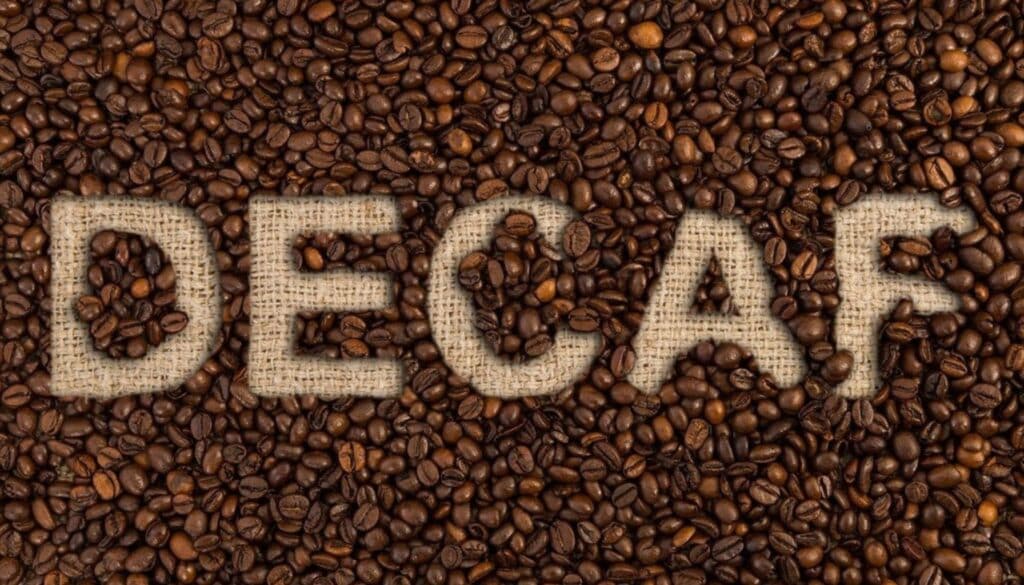
Caffeine is a natural stimulant most commonly found in tea, coffee, and cacao plants. It works by stimulating the brain and central nervous system, helping you stay alert and prevent the onset of tiredness. Chemically known as 1,3,7-trimethylxanthine, caffeine has a molecular structure similar to adenosine, a compound in your body that promotes sleep. By blocking the adenosine receptors without activating them, caffeine prevents the onset of drowsiness induced by adenosine. This interference not only reduces fatigue but can also improve concentration and focus.
How Caffeine Affects the Body
The effects of caffeine on the body can be wide-ranging and vary significantly from one individual to another, depending on factors like body mass, tolerance, and sensitivity. Commonly reported effects include:
- Increased Alertness: Caffeine’s primary effect is a reduced sensation of tiredness and increased levels of alertness and attentiveness.
- Boosted Physical Performance: By increasing adrenaline levels and breaking down body fat to free fatty acids for fuel, caffeine can enhance physical performance.
- Digestive and Diuretic Effects: Caffeine increases the release of acid in the stomach, sometimes leading to an upset stomach or increased bowel movement. It also acts as a mild diuretic, which can cause more frequent urination.
- Heart Rate and Blood Pressure: For some people, caffeine can cause a temporary increase in heart rate and blood pressure.
- Sleep Disturbances: Consuming caffeine late in the day can interfere with sleep patterns, causing difficulties falling asleep or reducing sleep quality.
The Amount of Caffeine Typically Found in Coffee
The caffeine content in coffee can vary widely depending on several factors, including the type of coffee bean, how the coffee is brewed, and the serving size. On average, a standard 8 ounce (240 ml) cup of coffee contains about 95 mg of caffeine, but the range can be anywhere from 70 to 140 mg. Espresso, often served in smaller servings, is more concentrated, with about 63 mg of caffeine per 1 ounce (30 ml) serving. In contrast, decaf coffee is not completely caffeine-free but contains a much lower amount, typically 2 to 5 mg per 8 ounce cup.
Understanding these effects and the typical caffeine content in coffee can help individuals make informed decisions about their coffee consumption, balancing the enjoyment of coffee with its potential impact on their health and well-being.
The Decaffeination Process: Overview
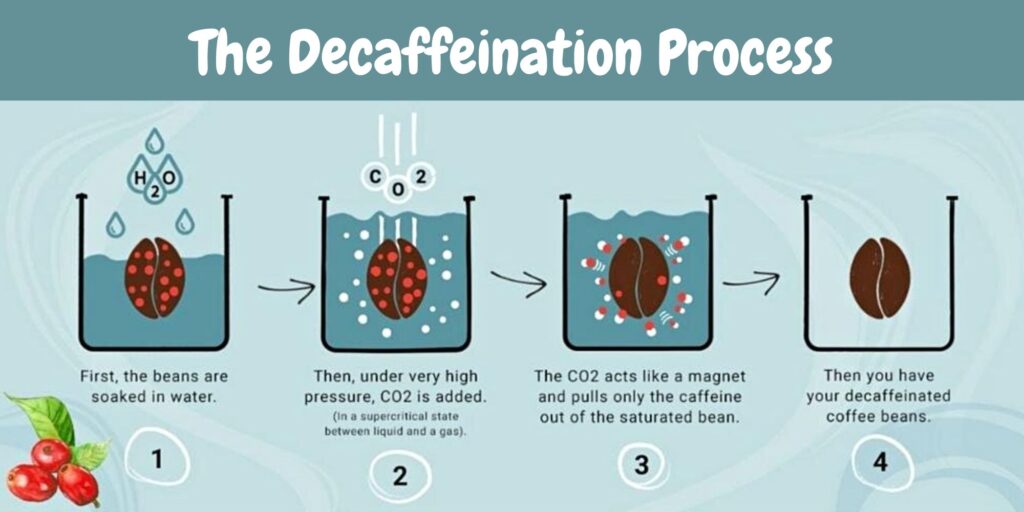
The decaffeination process involves removing caffeine from coffee beans while striving to maintain the beans’ original flavor and aroma as much as possible. This delicate balance is challenging because caffeine is deeply intertwined with the other compounds that give coffee its distinctive taste. The process typically begins with green (unroasted) coffee beans, as the decaffeination process can affect the beans’ structural integrity and flavor profile, making it preferable to perform before roasting.
General Overview of How Decaf Coffee Is Made
- Preparation: Green coffee beans are first moistened or soaked in water to expand the beans and make the caffeine extraction easier. This initial step also helps to dissolve and remove caffeine from the coffee beans.
- Caffeine Extraction: Using one of several methods, the caffeine is extracted from the beans. This can involve water, organic solvents, or carbon dioxide. The choice of method depends on various factors, including cost, efficiency, and the desire to maintain the coffee’s flavor.
- Flavor Preservation: After the caffeine has been extracted, the beans are treated to ensure that they retain their natural flavors. For some methods, this may involve reintroducing some of the coffee oils and flavors that were lost during the caffeine extraction phase.
- Drying: The decaffeinated beans are then dried to their original moisture content, preparing them for roasting.
Different Methods of Decaffeination
There are several key methods used to decaffeinate coffee, each with its own advantages and disadvantages:
- Direct Solvent Method: Involves directly soaking the coffee beans in a chemical solvent (typically methylene chloride or ethyl acetate) to dissolve the caffeine, which is then washed away.
- Indirect Solvent Method: The beans are soaked in hot water to extract caffeine and other compounds into the water. The beans are then removed, and a solvent is used to extract caffeine from the water. The water is then returned to the beans to reabsorb their flavors.
- Swiss Water Process: A chemical-free, water-based process that relies on solubility and osmosis to decaffeinate coffee. It uses a charcoal filter to remove caffeine from water-saturated beans without the use of chemicals.
- Carbon Dioxide Method: Utilizes supercritical CO2 as a solvent to extract caffeine. This method is efficient for large-scale decaffeination and has minimal impact on the flavor of the coffee.
Each of these methods has its own set of benefits and drawbacks, influencing factors such as taste, environmental impact, and health considerations. The choice of decaffeination process can significantly affect the final product’s quality, making it a critical decision for coffee producers.
Common Decaffeination Methods

Direct Solvent Method
Description of the Process
The Direct Solvent Decaffeination Method involves treating green coffee beans directly with a chemical solvent to remove caffeine. Initially, the beans are steamed for about 30 minutes to open their pores. Following this, the beans are repeatedly rinsed with a solvent that selectively bonds with caffeine molecules. Once the caffeine has been dissolved by the solvent, the beans are then steamed again to remove any residual solvent, ensuring that the final product is as pure and safe as possible.
Solvents Used in the Process
The most commonly used solvents in this method are methylene chloride and ethyl acetate. Methylene chloride can selectively remove caffeine while having a low boiling point, which makes it easier to remove from the coffee bean post-extraction. Ethyl acetate, often derived from fruits or sugarcane, is considered a more natural option and is sometimes marketed as “naturally decaffeinated” coffee.
Advantages and Disadvantages
- Advantages:
- Efficient at removing caffeine.
- Retains a significant amount of the coffee’s original flavor and aroma.
- The process is relatively quick and cost-effective.
- Disadvantages:
- Use of chemical solvents raises health and environmental concerns, although the solvents are carefully removed from the final product.
- Some coffee enthusiasts argue that the use of solvents can slightly alter the taste and smell of the coffee.
Indirect Solvent Method
Description of the Process
In the Indirect Solvent Decaffeination Method, the green coffee beans are soaked in hot water for several hours, which extracts caffeine along with other flavor compounds into the water. The beans are then removed, and a solvent is introduced to the water to remove the caffeine. After the caffeine has been removed, the beans are reintroduced to the solution, allowing them to reabsorb the flavor compounds but not the caffeine. This method ensures that the coffee maintains its original flavor profile as much as possible.
How It Differs from the Direct Solvent Method
The primary difference lies in the initial step; in the indirect method, caffeine is extracted into water rather than directly contacting the beans with a solvent. This results in the flavor compounds being retained in the water, which are then reabsorbed by the beans, theoretically preserving more of the original flavor.
Advantages and Disadvantages
- Advantages:
- Does not directly expose the beans to solvents, which may alleviate some health and safety concerns.
- Can maintain a high degree of the coffee’s original flavor and aroma by reabsorbing the flavor compounds from the water.
- Disadvantages:
- More time-consuming and complex than the direct solvent method.
- Can be less efficient at removing all the caffeine compared to direct methods.
- The process can lead to a loss of some flavor compounds, potentially affecting the final taste.
Both methods have their unique approaches and considerations, with the choice between them often depending on the desired balance between efficiency, flavor preservation, and health and environmental considerations.
Swiss Water Process
Explanation of the Process
The Swiss Water Process is a chemical-free, decaffeination method that relies on solubility and osmosis principles to decaffeinate coffee beans. Initially, green coffee beans are soaked in hot water to dissolve the caffeine. This water becomes saturated with coffee flavors and caffeine. The caffeine-laden water is then passed through a charcoal filter, which traps caffeine molecules while allowing the smaller oil and flavor molecules to pass through. The resulting caffeine-free, but flavor-rich, water (known as Green Coffee Extract or GCE) is then used to soak a new batch of coffee beans. Since the GCE is already saturated with flavor compounds, only the caffeine is extracted from the new beans, leaving the flavor intact.
Why It’s Considered a Chemical-Free Method
This process is considered chemical-free because it uses only water and a charcoal filter to remove caffeine from the coffee beans, without the need for chemical solvents. The Swiss Water Process relies on natural elements and physical filtration methods, making it an entirely organic and chemical-free approach to decaffeination.
Advantages and Disadvantages
- Advantages:
- Completely chemical-free, making it a healthier and more environmentally friendly option.
- Preserves the original flavor profile of the coffee beans to a great extent.
- Preferred by organic coffee consumers and producers.
- Disadvantages:
- More time-consuming and costly compared to chemical-based methods.
- Can result in a slight loss of coffee flavor compounds, as some may be lost during the initial soaking process.
Carbon Dioxide Method
Description of the Process
The Carbon Dioxide (CO2) Method uses supercritical CO2—CO2 in a fluid state due to being kept at high pressure and temperature—as a solvent to extract caffeine from coffee beans. In this process, green coffee beans are placed in an extraction vessel where they are exposed to pressurized CO2. The supercritical CO2 acts selectively on caffeine, leaving the flavor compounds largely unaffected. After caffeine is absorbed by the CO2, the pressure is released, and CO2 returns to its gaseous state, leaving behind the decaffeinated coffee beans. The caffeine is then separated from the CO2 for reuse.
Why It’s Considered an Environmentally Friendly Method
The CO2 Method is considered environmentally friendly because the CO2 is recycled and reused within the system, minimizing waste. Additionally, it doesn’t rely on chemical solvents, reducing the risk of environmental contamination. The closed-loop system ensures that CO2 emissions are kept to a minimum, aligning with sustainability goals.
Advantages and Disadvantages
- Advantages:
- Efficient at removing caffeine while preserving the coffee’s original flavor.
- The CO2 used in the process is recyclable, making it a more sustainable option.
- Considered safe and environmentally friendly as it avoids the use of harmful chemical solvents.
- Disadvantages:
- Requires sophisticated equipment and technology, making it more expensive than other methods.
- The high cost and complexity limit its use primarily to high-quality or specialty coffee products.
Both the Swiss Water Process and the Carbon Dioxide Method offer eco-friendly alternatives to traditional solvent-based decaffeination processes, each with its own set of benefits and considerations for coffee producers and consumers alike.
Comparing Decaffeination Methods

Decaffeination methods vary in their impact on coffee flavor, health considerations, and environmental footprint. Here’s a comparison of the key aspects of the most common decaffeination processes:
Flavor Impacts
- Direct Solvent Method: Generally preserves the coffee’s original flavor well, though some purists argue that the chemical solvents used can slightly alter the taste and aroma. The precision of this method in targeting caffeine while leaving other compounds intact contributes to its ability to maintain flavor.
- Indirect Solvent Method: This method is also effective in preserving the coffee’s original flavor since the beans are re-soaked in a solution that contains their original oils and essences. However, the process can lead to a slight dilution of flavor due to the initial extraction phase.
- Swiss Water Process: Highly praised for its ability to decaffeinate coffee without chemical solvents, thereby preserving much of the bean’s natural flavor profile. However, some slight loss of flavor complexity can occur since all water-soluble compounds are initially extracted, not just caffeine.
- Carbon Dioxide Method: Offers a good balance between caffeine removal and flavor preservation, thanks to the selective nature of supercritical CO2. This method is especially effective for high-quality coffee, as it minimizes flavor loss while extracting caffeine.
Health Considerations
- Direct and Indirect Solvent Methods: There have been health concerns related to the use of chemical solvents like methylene chloride and ethyl acetate, although the final product contains negligible amounts of these chemicals. Regulatory bodies ensure that coffee decaffeinated using these methods meets strict safety standards.
- Swiss Water Process and Carbon Dioxide Method: Both are considered safer, health-friendly alternatives since they do not use chemical solvents. These methods are especially appealing to consumers looking to avoid any potential chemical residues.
Environmental Impacts
- Direct Solvent Method: Uses chemical solvents that need to be managed properly to avoid environmental contamination. While modern practices involve recycling and safe disposal of these solvents, there’s still an environmental impact associated with their production and use.
- Indirect Solvent Method: Similar to the direct method, though the indirect contact with the beans might slightly reduce the solvent’s environmental footprint. Still, solvent recovery and recycling are critical to minimize environmental effects.
- Swiss Water Process: Considered environmentally friendly as it uses only water and activated charcoal, both of which have minimal environmental impact. This method does not contribute harmful chemicals to the environment, making it a preferred choice for eco-conscious consumers and producers.
- Carbon Dioxide Method: The use of CO2 in a closed-loop system minimizes environmental impact, making it an eco-friendly option. The ability to recycle and reuse CO2 within the process reduces greenhouse gas emissions, aligning with sustainability goals.
In summary, while all decaffeination methods aim to remove caffeine with minimal impact on coffee flavor, their health and environmental considerations vary. The Swiss Water Process and Carbon Dioxide Method stand out for their eco-friendly and health-conscious approaches, though they may come with higher costs due to the complexity and efficiency of these methods.
How to Choose the Right Decaf Coffee

Selecting the right decaf coffee involves understanding what contributes to its quality, flavor, and the methods used in its decaffeination process. Here are some tips on choosing high-quality decaf coffee, along with an explanation of relevant labels and certifications that can guide your decision.
Tips on Selecting High-Quality Decaf Coffee
- Consider the Decaffeination Method: Look for coffee that uses a decaffeination process aligning with your health and environmental preferences. Swiss Water Process or Carbon Dioxide Method decafs are often preferred for being chemical-free and retaining a rich flavor profile.
- Origin and Bean Quality: High-quality decaf starts with high-quality beans. Look for single-origin decaf coffees, which often indicate more care in the selection and decaffeination process, preserving unique flavor profiles.
- Roast Date: Freshness affects flavor, and this is true for decaf coffee as well. Look for decaf coffee with a clearly marked roast date, and choose the freshest beans possible.
- Roast Type: The roast level can significantly influence the flavor of decaf coffee. Medium and dark roasts tend to retain more flavor after decaffeination, but choose according to your personal taste preference.
- Brand Reputation: Research brands and read reviews to find those known for producing high-quality decaf. Specialty coffee roasters often put more effort into sourcing and roasting decaf coffee.
Understanding Labels and Certifications
- Decaffeination Method: Some labels will specify the decaffeination process used, such as “Swiss Water Process” or “CO2 Process.” This information can help you choose a product that meets your preferences for flavor and health considerations.
- Organic Certification: Organic certifications, such as USDA Organic in the United States, indicate that the coffee was grown without synthetic pesticides and fertilizers. When combined with a chemical-free decaffeination process, this certification can assure you of a product that is both environmentally friendly and healthier.
- Fair Trade Certification: This certification ensures that the coffee was purchased from farmers at a fair price, promoting sustainable farming practices and improving farmers’ livelihoods. Choosing Fair Trade decaf supports ethical sourcing practices.
- Rainforest Alliance Certified: This label indicates that the coffee was produced using methods that support social, economic, and environmental sustainability. It focuses on protecting ecosystems, workers, and local communities.
- Direct Trade: While not an official certification, direct trade indicates that roasters buy directly from farmers, often resulting in higher quality and more sustainable practices. Look for decaf coffees that tout direct trade relationships.
By paying attention to these tips and understanding what different labels and certifications mean, you can make more informed choices about the decaf coffee you purchase. This ensures that your coffee not only tastes good but also aligns with your values and health preferences.
The Future of Decaf Coffee

The future of decaf coffee looks promising, with ongoing innovations in decaffeination technology and shifting consumer preferences driving changes in the industry. These developments are set to offer coffee lovers more options that don’t compromise on taste or health and environmental considerations.
Innovations in Decaffeination Technology
- Enhanced Solvent-Based Methods: Although solvent-based methods have faced criticism, advancements are making these processes safer and more environmentally friendly. New, green solvents derived from renewable sources are being explored to reduce environmental impact and health risks while maintaining efficiency in caffeine extraction.
- Improved Swiss Water and CO2 Processes: Both the Swiss Water Process and the Carbon Dioxide Method are seeing refinements to increase efficiency and flavor preservation. Innovations include better filtration systems and more precise control over processing conditions, ensuring that decaf coffee retains as much of its original character as possible.
- Emerging Technologies: Research into new decaffeination methods continues to evolve. Techniques such as using superheated water, ultrasound-assisted extraction, and even genetic engineering to grow caffeine-free coffee plants are in the exploratory stages. These methods promise to offer more sustainable and health-conscious alternatives for decaf coffee production.
Trends in Consumer Preferences
- Demand for Quality and Flavor: Consumers are increasingly seeking decaf coffee that matches the quality and taste of regular coffee. This trend is pushing roasters and producers to focus on sourcing high-quality beans and refining decaffeination processes to preserve the beans’ inherent flavors.
- Health and Wellness: As people become more health-conscious, there is a growing interest in decaf coffee among those looking to reduce caffeine intake without giving up coffee altogether. This includes younger consumers, who are more likely to explore decaf options as part of their wellness routines.
- Transparency and Sustainability: Consumers are not only interested in the final product but also in how it’s made. There is a rising demand for transparency in the decaffeination process and a preference for methods that are environmentally friendly and socially responsible. Certifications like Organic, Fair Trade, and Rainforest Alliance are becoming more important to consumers.
- Specialty and Craft Decaf: Mirroring the broader trend in the coffee industry, there is an increase in specialty decaf offerings. Small-batch roasters are focusing on single-origin decaf coffees and innovative roasting techniques to create unique and high-quality decaf options.
- Convenience and Variety: With the rise of home brewing and the popularity of coffee culture, consumers are seeking decaf coffee in various forms, including whole beans, ground coffee, and pods for single-serve machines. This demand for convenience without sacrificing quality is driving innovation in packaging and product offerings.
The future of decaf coffee is shaped by technological advancements and changing consumer demands, with a focus on quality, health, and sustainability. As decaffeination technology improves and consumer awareness grows, decaf coffee is set to become an even more integral part of the coffee industry, offering choices that appeal to a wide range of preferences and lifestyles.
Conclusion
Understanding the intricacies of decaf coffee production is crucial for both consumers and industry players. It sheds light on the sophisticated processes behind transforming everyday coffee beans into a product that maintains the beloved taste and aroma of coffee, minus the caffeine. This knowledge empowers consumers to make informed choices that align with their health preferences, ethical considerations, and taste expectations. It also enables producers and roasters to innovate and improve, ensuring that decaf coffee continues to evolve in quality and sustainability.
The evolution of decaf coffee from its early chemical-based processes to the advanced and diverse methods available today reflects a broader shift towards more health-conscious and environmentally sustainable consumer preferences. Innovations in decaffeination technology, along with a growing emphasis on quality and transparency, are setting the stage for a future where decaf coffee stands equal to its caffeinated counterpart in terms of flavor, variety, and enjoyment.
Looking ahead, the future of decaf coffee appears vibrant and promising. As consumer demand for quality and sustainability grows, the coffee industry is likely to respond with even more innovative decaffeination techniques, specialty decaf offerings, and transparent practices. This progress will not only enhance the decaf coffee experience but also contribute to a more sustainable and health-conscious global coffee culture. Ultimately, the journey of decaf coffee is a testament to the coffee community’s resilience, creativity, and commitment to meeting the diverse needs of coffee enthusiasts around the world.
References and Further Reading
- National Coffee Association. (n.d.). Decaffeinated Coffee. Retrieved from https://www.ncausa.org/Decaffeinated-Coffee
- Geggel, L. (2019, March 8). How Decaf Coffee Is Made. LiveScience. Retrieved from https://www.livescience.com/65278-how-decaf-coffee-is-made.html
- Encyclopedia Britannica. (n.d.). How is coffee decaffeinated? Retrieved from https://www.britannica.com/story/how-is-coffee-decaffeinated
